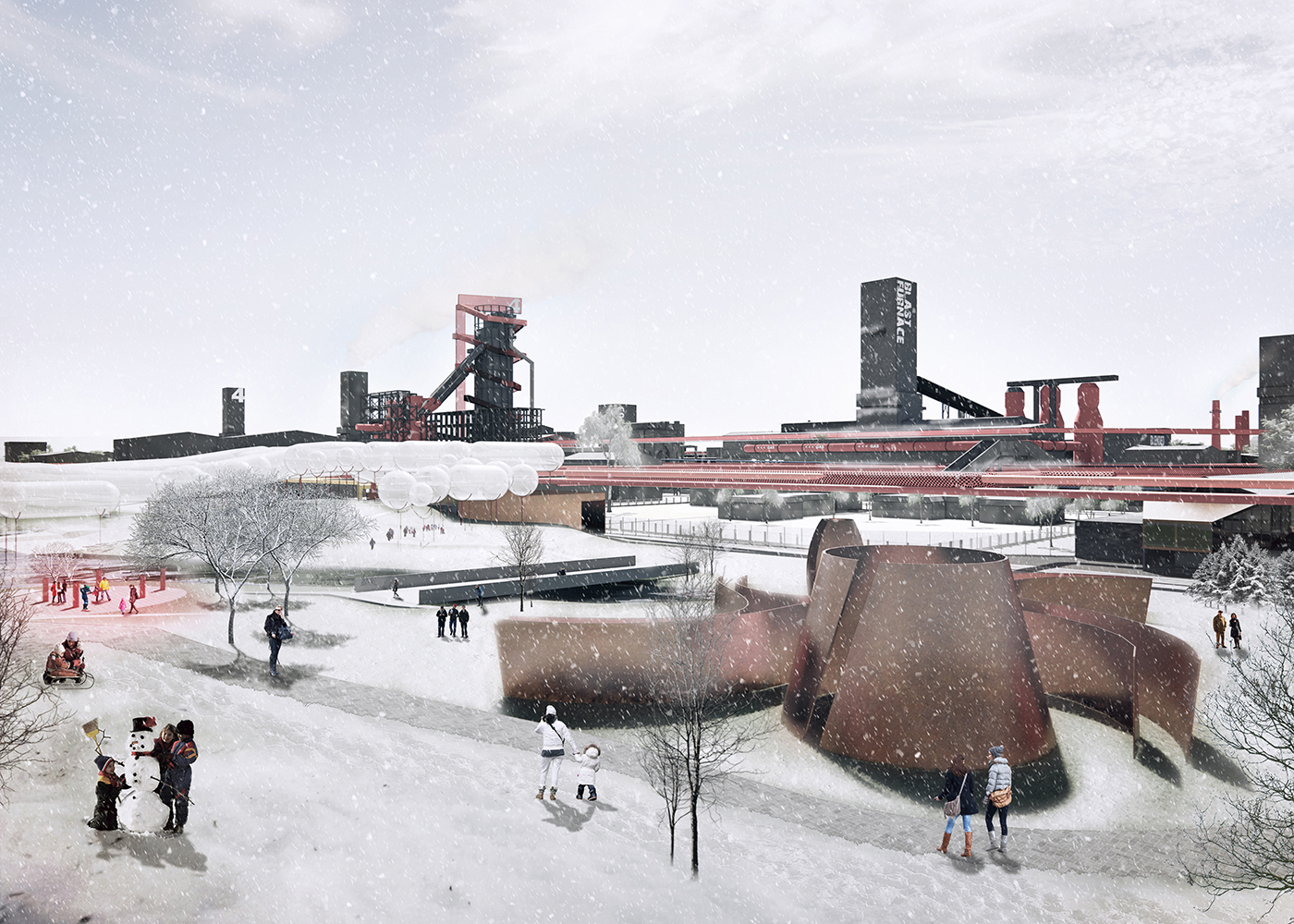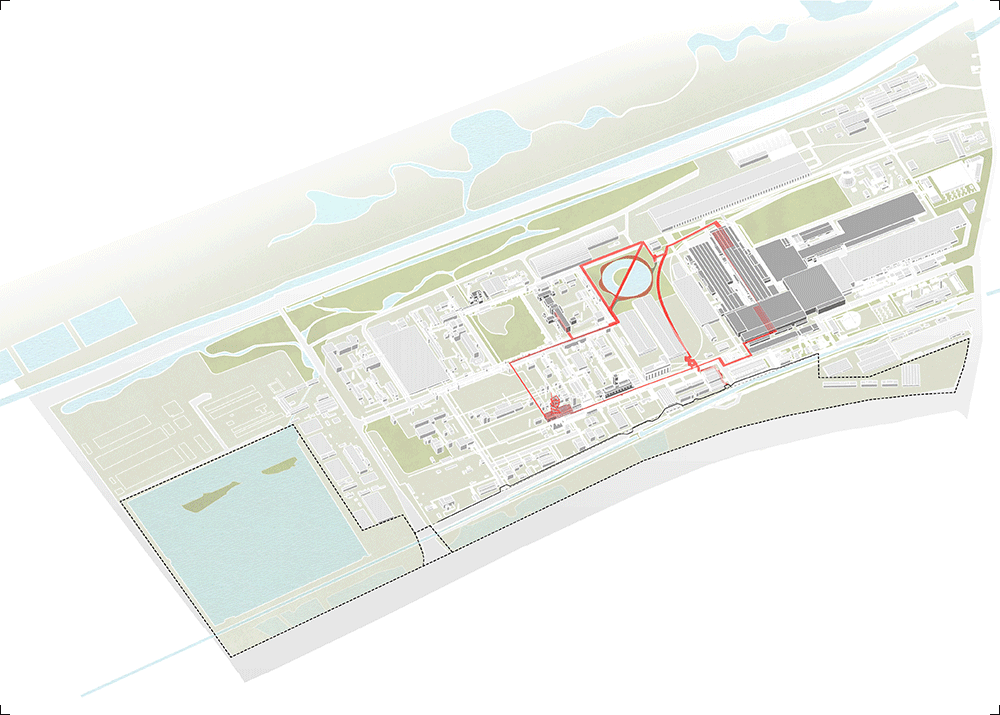steel+
Year: 2020
Size: 330 ha
Type: masterplan
Status: competition
Location: Tianjin, China
Client: Tianjin Rockcheck Steel Group
Partners in charge: Chen Chen, Nicola Saladino
Design team: Javier Pelaez, Meikang Li, Shoutuo Lyu, Ziyao Zhang, Yiren Wang, Marco Navarro

A factory in the city. The
accelerated urban development in China is challenging the models of large-scale
infrastructure and industry traditionally relegated to the countryside. Tianjin
Rockcheck steel factory is located in the middle of the two growing urban cores
of Tianjin: the historic city and the new development of Binhai. The current
factory is a black box, isolated from its surrounding urban and ecological
systems, urging a change of model to prevent relocation. The city is knocking
on a door until now closed.
Opening the black box. Three
interventions to weave the internal ecology of the factory with that of its
context:
A continuous landscape. The green
loop connects the permeable grounds inside the factory with the parks in the
south and north of the factory, a system of brownfield remediation gardens and
stormwater management strategies with phytoremediation processes clean the
water before pouring it to the exterior ditches.
An educational factory. The red loop
follows an elevated walkway protecting the visitor along the steelmaking
process, making it visible. It grows to host new programs (café and tourism
facilities) and provide new points of view of the factory as a whole
(observation towers).
A performative interface. The steel
park is a space of dialog within the factory and the city. The metabolism of
the steelmaking process is exported to 9 programmatic pavilions distributed
along the park. This influx of hot water, gas, and material slag is injected in
the context of each pavilion, creating a continuous gradient in the stripes
separating the sequence of programs.
The
park is a journey interweaving the harmonic flows of humans and energy: the
leftover gas is used in pneumatic canopies along the park that inflate and
deflate reflecting the periodic timing of the processes inside the factory;
heat and water is sprayed along the park to form clouds of mist and(or) heat
that appear and disappear, inviting the user to continue moving; the stormwater
management generates a playful landscape articulated with the topography of the
park, guiding cleaning and using the water until poured to the reservoir in the
west; the slag and material leftover is used to fill these topographies, to
build the vegetation beds of the reservoir wetlands and to create sculptures
and landscape features growing in time.
(open)
factory let the nature through the box, let the city enter the box and let the
box out of the box. It is a celebration of the steelmaking industry potential
to become an educational example of environmental protection, of collaboration
and transparency and an important player promoting values and initiatives to
engage with local communities.
城里有一家工厂。 中国城市的加速发展正在挑战传统上位于农村的大规模基础设施和工业模式。 天津瑞克克钢铁厂位于天津两个不断发展的城市核心:历史名城和滨海新区的中间。 目前的工厂是一个黑匣子,与周围的城市和生态系统隔离,敦促改变模式以防止搬迁。 这座城市一直在敲门,直到现在才关闭。
打开黑匣子。 将工厂内部生态与其周围环境交织在一起的三种干预措施:
连续的风景。 绿色环路将工厂内的透水地面与工厂南部和北部的公园连接起来,这是一个棕地修复花园系统和雨水管理策略,采用植物修复工艺,在将水倒入外部沟渠之前对其进行清洁。
一个教育工厂。 红色环路沿着一条高架走道,保护炼钢过程中的游客,使其可见。 它不断发展以举办新的项目(咖啡馆和旅游设施)并提供整个工厂的新视角(观景塔)。
一个高性能的界面。 钢铁公园是工厂和城市之间的对话空间。 炼钢过程的新陈代谢被输出到分布在公园沿线的 9 个功能性展馆。 热水、气体和材料炉渣的涌入被注入到每个展馆的环境中,在分隔项目序列的条纹中形成连续的梯度。
该公园是一段人类与能源和谐流动交织在一起的旅程:剩余的气体被用于公园沿线的气动天篷,其充气和放气反映了工厂内部过程的周期性时间; 热量和水沿着公园喷洒,形成雾气和(或)热量,时隐时现,吸引用户继续移动; 雨水管理产生了一个与公园地形相结合的有趣景观,指导清洁和使用水,直到倒入西边的水库; 矿渣和剩余材料被用来填充这些地形,建造水库湿地的植被床,并创造随着时间的推移而生长的雕塑和景观特征。
(开放)工厂让自然穿过盒子,让城市进入盒子,让盒子走出盒子。 这是对炼钢行业潜力的庆祝,它有潜力成为环境保护、合作和透明度的教育典范,并成为促进与当地社区互动的价值观和举措的重要参与者。















